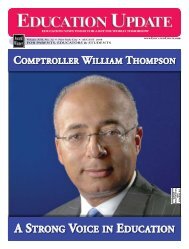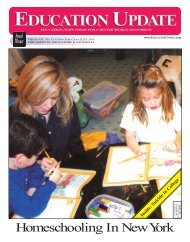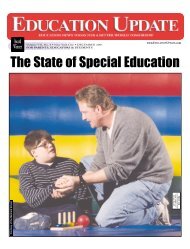Download PDF - Education Update
Download PDF - Education Update
Download PDF - Education Update
Create successful ePaper yourself
Turn your PDF publications into a flip-book with our unique Google optimized e-Paper software.
NOV/DEC 2010 ■ EDUCATION UPDATE ■ museums as educatorsExhibit DramatizesInsulin Discoveryby Jan AaronSince the hormone insulin was first isolatedin Toronto and produced in Indianapolis, Iwondered why the New-York Historical Societychose to feature an exhibit called “Breakthrough:The Dramatic Discovery of Insulin.” There’sa scant connection: An exhibit is devoted toElizabeth Hughes, one of the earliest and mostfamous insulin patients; she was the daughterof Charles Evans Hughes, the onetime secretaryof state, New York governor, and supreme courtjustice. Still, why should we quibble about localrelevance? The show is expertly researchedand handsomely presented. It is relevant to ourtimes, and we can be proud that it’s here.Combining graphics, easy-to-read text, artifactsand illustrations, it offers a clear explanationfor novices to this subject: what diabetesis, how deadly it was, and who made it less so.Those with more experience (diabetics, or thosewith diabetic friends or family) will be mesmerizedby the historical objects in the show: letters,research notes. There is a telegram telling Dr.Frederick Banting, one of the co-discoverers ofinsulin, that he and his colleague had won theNobel Prize in physiology or medicine. Alsoriveting are objects such as syringes, ampoules,and early kits to test sugar in urine and blood.“That’s Like Me!”: Stories About AmazingPeople with Learning Differencesby Jill Lauren, MAPublished by Star Bright Books, New York: 2009NY HISTORICAL SOCIETY“Daughter of U. S. Secretary of StateTries New Toronto Discovery,” TorontoDaily Star, August 17, 1922. (Fromthe Thomas Fisher Rare Book Library,University of Toronto.)BOOK REVIEWThat’s Like Me!Photograph of Elizabeth Hughes withher mother, summer, 1918. ( From theThomas Fisher Rare Book Library,University of Toronto.)The new book “Breakthrough” by Thea Cooperand Arthur Ainsberg, which inspired this show,offers readable explanations. But the exhibitsdivulging personal stories bring the insulin storyto life. Pages from a doctor’s registry before thediscovery of insulin lists patients’ names, datesof diagnosis, and dates of death; post-discovery,the death rates change drastically. My favoriteexhibit shows a letter from Teddy Ryder, anearly insulin patient. Scrawled in pencil andclumsy capital letters, he tells Dr. Banting: “I’ma fat boy now and I feel fine. I can climb a tree.”Photos adjacent juxtapose a skinny, sickly Ryderin 1922 with a plump, smiling one a year laterand 23 pounds heavier.Text reminds the viewer that insulin transformeddiabetes from a fatal disease to a chronicone. The show emphasizes that insulin is nota cure; it’s a treatment, and diabetics are sick.You’ll also learn that in the 90 years since insulinwas discovered, no further advances have beenmade, and, more depressingly, diabetes rateshave remained steady or rising worldwide. #The exhibit is displayed through January 31,2011 at the New-York Historical Society, locatedat 2 West 77th Street. For more information,call (212) 873-3400, or visit http://www.nyhistory.orgBy Merri RosenbergA trapeze artist, fire fighter, veterinarian, inventor,event producer, dancer, award-winning illustrator— there’s not much that would seem to linkthese disparate people.What they share, as revealed in Jill Lauren’ssurprisingly brave touching children’s book,“That’s Like Me!”, is a common history ofstruggling with school and academic pursuitsbecause of learning differences. Some of theselearning disabilities were recognized early inthe subjects’ school careers, with several speakingabout their positive experiences in smallresource room classes, or the encouragementthey received from teachers and parents. Othersstruggled through school, only finding their waywhen they received an appropriate diagnosis incollege or beyond.As illustrator Jerry Pinkney writes in his foreword,“My learning disability was not recognizedor considered, thereby making it invisible, whichcaused me to find ways of keeping in unseen. Ilearned to excel in areas where I was strong andhide those places where there was a challenge.”One of the author’s goals in writing this bookand sharing these stories — which interspersethose of the adults with poignant stories fromchildren currently in school, who define themselvesas an artist, scientist, wrestler and EagleScout — is to offer inspiration and hope to childrenand their parents.‘That’s Like Me!’ is designed to inspire, educateand empower children with learning disabilities,”writes Lauren, a teacher who specializesin the field and works with children and adults.“Finally, some of your child’s connections to thestories may be emotionally based, and reading theprofiles may lead to important discussions aboutfeelings related to learning differently.”For a slender volume, this packs quite a powerfulpunch, one that I’m sure will resonate withspecial education teachers as well as parents andchildren who deal, daily, with the challenges ofthese learning differences. #Holocaust Center Makes aDifference in Life of CommunityBy Joan Baum, Ph.D.Coincidentally, the very day <strong>Education</strong> <strong>Update</strong>paid a visit to the Holocaust Memorial andTolerance Center of Nassau County, a leadingregional newspaper with national reach rana front-page piece on bullying in schools. ToBeth Lilach, the senior directorof education at the center, theheadlined feature underscoredthe mission of HMTC, which,despite its name and nearbyChildren’s Memorial Garden,does not restrict itself to tellingthe tragic story of Jews murderedduring World War II, orof state-sanctioned antisemitismin history. Indeed, the center hasalso taken on a broader charge— to depict, explain and preventbehavior such as bullyingthat all too frequently erupts asracial, homophobic and ethnicintolerance and genocide. In thewords of center chairman Howard S. Maier,“the Holocaust did not begin with concentrationcamps and killing. It started with stereotyping,intolerance and prejudice.” This theme is impressivelyon display in gallery rooms along withHolocaust artifacts and mixed-media testimonials,not just to the Holocaust but to those whostood up against oppressors.Located in an elegant neo-Georgian mansionset deep in the woods of Welwyn Preserve inGlen Cove, the center, the former home of oilindustrialist Harold Irving Pratt, still seems to berelatively unknown even though it has been inexistence for 16 years, reopened several monthsago after extensive renovation, and has beenengaged for some time in significant communityoutreach. And not just in Nassau County. HMTCserves the greater New York City area, includingQueens and Suffolk Counties, by providing freeon-site programs and tours for schools, sponsoringlectures and conferences for adults, and offeringtraveling exhibitions.The connection between memorializing Jews— and non-Jews, such as people with disabilitiesand the Roma — as well as others murdered byvicious regimes in the last century — and morerecent victims of genocide in Cambodia, Burma/Myanmar, Bosnia, Sudan, Rwanda, Iraq — is atthe heart of the lessons the center would teach.This theme is only one feature that differentiates— and distinguishes — the center fromother museums and educational institutions withsimilar goals. Another is its choice of teachers:survivors and liberators come to the center to talkabout their experiences and to provide, by theirvery existence, inspiration. As Beth Lilach pointsout, however, time is running out. These eyewitnesseswere children when history cast them intheir roles, but of course their indelible stories areThe U.S.-Israel Citizenship ThroughSports Exchange is a program sponsoredby the America-Israel FriendshipLeague, a non-profit organization. Theprogram, which was founded by Drs.Cedric and June Dempsey, offers activitiesthat promote skills in communication,conflict resolution and goodsportsmanship to young American andIsraeli student-athletes. Nearly 100high schools in Israel have added theprogram to its extracurricular activitiesand efforts are being made to introducethe the Citizenship through SportsExchange program to schools in theUnited States. For more information,visit http://www.aifl.org. #Chairman Howard Maier25part of the center’s permanent exhibit of films,photographs and written accounts.Begun in 1994 in response to a felt needexpressed by survivors and their families wholived in Nassau County, the 2,500-square footcenter has the advantage of scale. It is smallenough to engage children andadults in manageable time periods.HMTC is essentially aneducational institution, servingpublic, private and parochialschools, and to that end it hasassembled an impressive arrayof age-appropriate curriculummaterials that teachers can borrowfor free. It also providesclassroom space for toleranceworkshops that follow presentationsand tours. For example,the center has two DVDs formiddle school and high schoolstudents that focus on survivorsdiscussing how they sufferedintolerance in their childhoods. Their narrativesare set against a background of archival footage.One DVD is 14 minutes long, the other 15.Why the one-minute difference? Because a verygraphic scene has been edited out for 5th-graders,Ms. Lilach says. Even so, as she notes, when sheand Howard Maier look in on presentations, theycan often hear collective gasps, even crying. Thepoint, however, is not to terrify youngsters butto educate them, to hope that being at the centerwill constitute “life-changing moments” for themand to encourage their continuing interest (thecenter sponsors literary and art competitions), animportant consideration as staff members discussprogram plans for K through 4.Another unique feature of HMTC of NassauCounty is its offering of professional developmenttolerance programs for employers, educators,law enforcement and other professionals,such as school superintendents, curriculumdirectors, the North Shore-LIJ Health Systememployees, attorneys and physicians. The centeralso provides full-day training to every newrecruit class in the Nassau and Suffolk CountyPolice Academies.It is important, Ms. Lilach points out, that thelast gallery all visitors go through is one thatemphasizes two critical lessons: 1) that liberationof the concentration camps in 1945 did not endtyranny, racism, antisemitism or genocide; and2) that there were, are, and can continue to be“upstanders” — those who refuse to be passive inthe face of intolerance and violence. Awarenessis fine, action is finer. “There is no such thingas neutrality in terms of genocide.” HMTC ofNassau County is an important resource that allpeople should put on their must visit list. Now. #100 Crescent Beach Road, Glen Cove. (516)571-8040. http://www.holocaust-nassau.orgU.S-Israeli Program PromotesGood Sportsmanship(L-R) Rina Mosseri, AIFL representative;Tomer Israeli; Gal Geva; Dr. Charlotte Frank
















